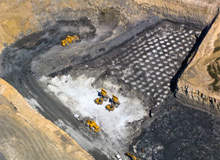
Explorers will soon have a knowledge source at their fingertips to help them tackle the challenge of finding mineral resources. The AuScope National Virtual Core Library (NVCL) is a research network that will offer users a detailed and high-resolution portrait of the composition and more specifically the mineralogy of the top 2km of the Australian continent.
Core libraries have existed for many years but they have not been used anywhere near this degree. The NVCL, which is part of the AuScope National GeoTransects Programme, has the goal of progressively building a novel high-resolution image bank of earth materials and properties – facilitating world-class geoscience research.
The NVCL will significantly increase the value of existing core libraries by scanning hundreds of thousands of core samples using Australia’s Commonwealth Scientific and Industrial Research Organisation (CSIRO)’s robotic, automated spectroscopic machines, called HyLoggers. It will then publish the detailed mineralogical data derived from that process.
These spectroscopic machines will reveal geological knowledge that is not readily evident to the naked eye. According to CSIRO exploration and mining’s programme director and chief research scientist Dr Jon Huntington: “Never before has such a comprehensive and accessible mineralogy map of Australia been available.”
Huntington says that the NVCL goes far beyond image banks that have been created before.
“Most government core libraries and company core ‘farms’ are large repositories for rocks and core samples that people can visit and examine but no-one has taken it to the next stage of developing a wholesale value-adding process to use those core assets,certainly not using hyperspectral techniques to derive mineralogy.”
He adds: “Neither has anyone put the results online for all to use either for research or more practical exploration activities.”
Huntington says that one goal of the NVCL is to encourage people to use knowledge from the past to drive ideas, exploration concepts and understanding, that will hopefully lead to future exploration and new resources.
Rich and wealthy content
The raw data for the library is based on the rich legacy of drill cores already held in roughly 18 core Australian libraries or informal core repositories in the seven state and territory geological surveys. Thousands of cores – some recent, some many years old – are already stored in these libraries and are publicly available. They have been drilled by state governments or donated by private companies.
The virtual online library will offer users the chance to examine detailed mineralogical results remotely before deciding to spend money on a formal visit to physically inspect the core.
The raw data will be found by a hyperspectral infrastructure made up of seven HyLoggers, one in each of the state and territory geological surveys. Each HyLogger consists of sensitive visible and infrared spectrometers, a very high-resolution digital camera, a laser profilometer, a robotic x/y table, power supplies, lighting, control software, and a control and data management computer.
The HyLogging systems are being built with funds from CSIRO and the National Collaborative Research Infrastructure Strategy. The geological surveys will own the HyLoggers, maintain them and provide operational staff as their co-investment in this project.
The sheer mass of information to be scanned and published is remarkable. According to the team, the project is producing roughly 3MB of processed data per metre of core scanned (the raw data also has to be stored).
“If a state geological survey manages to scan 100,000m in a year that would be 300,000MB or 300GB, and that’s just one survey,” says Huntington.
“This might amount to 4TB over the life of the current NVCL project. Moving this amount of material around on the internet is not trivial. Not everyone has internet speeds we in CSIRO are used to, so we have to be clever and offer alternative strategies to publish and deliver data. We are developing these as we proceed,” he adds.
Building a legacy
Explorers will be able to start viewing scanned results from about mid-2009. Huntington says that the NVCL team is building an Oracle database, a version of which will be provided to each state geological survey to implement.
“The AuScope Grid will access those databases, extract data and publish simplified versions to the internet for all to examine. Full resolution copies of the data will be available from the survey NVCL contacts called ‘custodians’ and maybe some of it over the internet,” he says.
According to Department of Primary Industries and Resources of South Australia executive director, minerals and energy Dr Paul Heithersay said: “NVCL allows for a totally new way to interrogate geological data from core. It has shown us, for example, that alteration zones can be much larger than previously recognised. It also allows for geologists to scan core remotely, so a visit to the core library is targeted and cost-effective.”
Hiethersay says that the state governments make a significant investment in storing and maintaining core for the use of explorers and he sees NVCL as adding more value to these important assets. The view from Queensland is equally positive. Geological Survey of Queensland geoscience information unit acting manager Ian Withnall says that NVCL’s role in providing a better understanding of mineralising and alteration processes in a mineral province should lower the risk associated with mineral exploration and increase the chance of discovery by both those companies already active and those that we would like to attract.
“Discovering a resource not only provides direct royalties to a government but provides employment and wealth that flows through the community and sustains our economy,” says Hiethersay.
The publicly funded NVCL will be built progressively as more and more core sample data are added over the coming years from government and private sources. Over time it will be a viable alternative to physically storing and retrieving trays of drill core.
This article first appeared in CSIRO’s magazine earthmatters.



